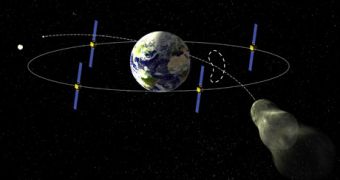Should we rely by 2036 on Bruce Willis' deep-core drilling skills or should we take a more scientific approach to the asteroid 99942 Apophis? By 2036, people on Earth could see the Armageddon movie turned into reality.
British space engineers have already unveiled designs for the development of a satellite that would track and monitor Apophis, the potential Earth-colliding asteroid discovered in 2004 and having a width of 390 m (1,300 ft).
Apophis will miss the Earth in 2029 just by 100,000 miles (160,000 km) but it could bang us when it swings by in 2036. An eventual collision would release over 100,000 times the energy expelled in the nuclear blast over Hiroshima. Everything on thousands of square km would be wiped out but the most severe effect will be induced by the dust lofted into the atmosphere.
Aerospace company Astrium has come with a proposal for a mission, named Apex, scheduled for 2013 and which will investigate Apophis. This is funded by the Planetary Society, an international scientific (and not only) group founded by Carl Sagan, which has come with a $50,000 prize for a mission meant to track Apophis.
"It is imperative to collect data on Apophis as soon as we can because once we know it's on a collision course the safest way to avoid disaster is to nudge the asteroid to change its orbit," said Mike Healy, Astrium's space science director.
"If we leave it too long it will be impossible to build a spacecraft powerful enough to move its orbit. Ideally we would need to nudge it before 2025 to be sure it misses."
Measurements made in December 2004 revealed that Apophis had a 1 in 37 chance of colliding into the Earth in 2029. Further measurements discarded the danger, but the asteroid still causes concern for April 13th, 2029, when it will approach enough to the Earth to be deflected in its orbit.
If that deflection makes it pass through a particular space point (keyhole), it will impact the Earth on its next passage, in 2036. In 2007, astronomers calculated the chance of Apophis passing through the keyhole, a 600 m (2,000 ft) space patch at 1 in 5,500.
Over 100 teams from 25 countries are going to present their designs to the Planetary Society competition and the winner could be chosen by NASA and the European Space Agency to develop its design.

 14 DAY TRIAL //
14 DAY TRIAL //